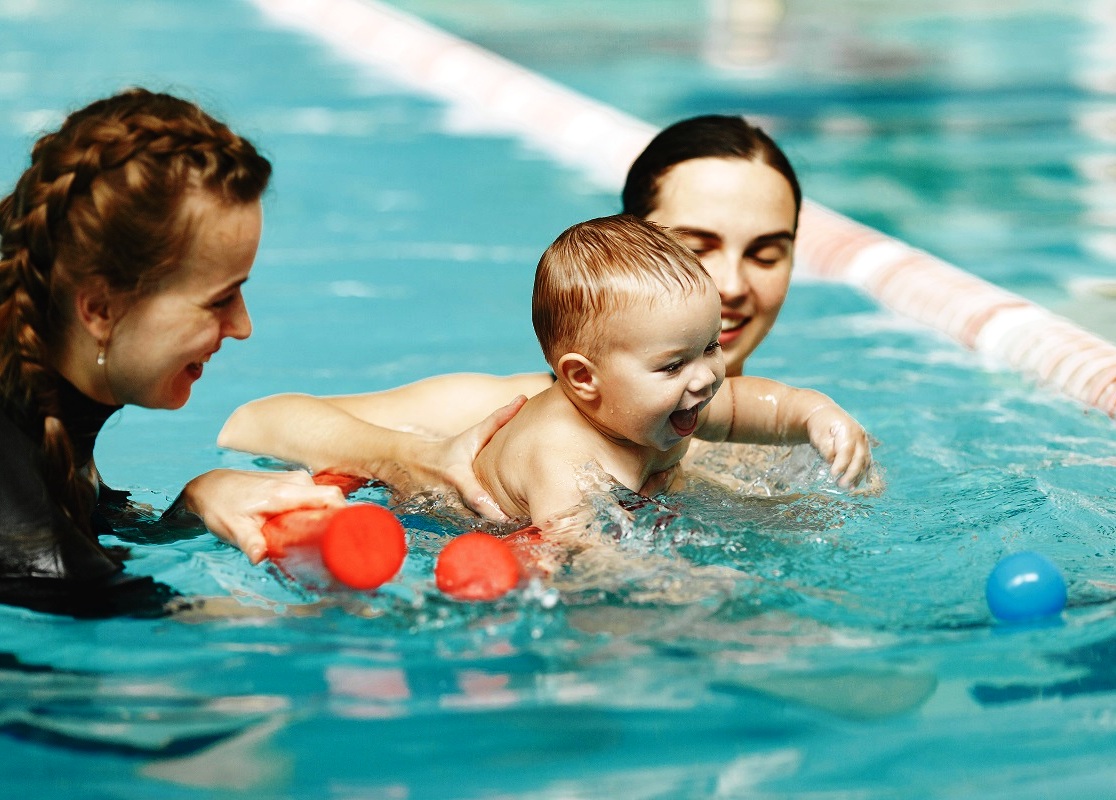Estudo piloto não randomizado sobre os benefícios da natação para o desenvolvimento motor de bebês

Downloads
Palavras-chave:
Cognição Incorporada, Desenvolvimento Motor, Natação Para BebêsResumo
De acordo com o conceito de “cognição incorporada”, o desenvolvimento motor não deve ser considerado distante dos processos cognitivos e de linguagem. O desenvolvimento motor é essencial nos primeiros 1000 dias de vida, pois a criança explora e aprende novas informações do ambiente. Entre as atividades motoras, a natação para bebês permite que os bebês façam movimentos que não são capazes de realizar em solo firme. Como os movimentos se tornam mais lentos na água, a percepção sensorial desses movimentos é amplificada. No entanto, a relação entre a experiência precoce de natação e o desenvolvimento motor ainda não foi investigada. Portanto, realizamos um estudo piloto com o objetivo de explorar essa relação pela primeira vez. Para tanto, foram recrutados 32 lactentes com idades entre 6 e 10 meses. A Peabody Developmental Motor Scale-2 foi utilizada para avaliar habilidades motoras em crianças saudáveis que praticaram regularmente cursos de atividades aquáticas em comparação com crianças que nunca praticaram natação. Os testes t de amostras independentes mostraram diferenças significativas a favor do grupo que realizou atividades de natação infantil nas medidas de reflexos (t = -2,2, p < 0,05), preensão (t = -3,8, p < 0,001), quociente motor fino (t = -3,4, p < 0,01) e quociente motor total (t = -2,4, p < 0,05). No geral, de acordo com a perspectiva da cognição incorporada, esses resultados preliminares são encorajadores e nos permitem investigar como o desenvolvimento motor influencia o desenvolvimento posterior da linguagem.
Referências
(1) Wellsby M, Pexman PM. Developing embodied cognition: Insights from children’s concepts and language processing. Front Psychol. 2014; 5: 506.
(2) Brunel L, Labeye E, Lesourd M, Versace R. The sensory nature of episodic memory: Sensory priming effects due to memory trace activation. J Exp Psychol Learn Mem Cogn. 2009; 35: 1081–1088.
(3) Brunel L, Carvalho PF, Goldstone RL. It does belong together: Cross-modal correspondences influence cross-modal integration during perceptual learning. Front Psychol. 2015; 6: 358.
(4) Heineman KR, Schendelaar P, Van den Heuvel ER, Hadders-Algra M. Motor development in infancy is related to cognitive function at 4 years of age. Dev Med Child Neurol. 2018; 60: 1149–1155.
(5) Loeffler J, Raab M, Cañal-Bruland R. A Lifespan Perspective on Embodied Cognition. Front Psychol. 2016; 7: 845.
(6) Vallet GT, Brunel, L, Riou, B, Vermeulen N. Editorial: Dynamics of Sensorimotor Interactions in Embodied Cognition. Front Psychol. 2016; 6: 1929.
(7) Lagerspetz K, Nygård M, Strandvik C. The effects of training in crawling on the motor and mental development of infants. Scand J Psychol. 1971; 12: 192–197.
(8) Zelazo PR, Zelazo, NA, Kolb S. Walking’ in the newborn. Science 1972; 176: 314–315.
(9) McGraw MB. Swimming behavior in the human infant. J Pediatr. 1939; 15: 485–490.
(10) Muslihatun WN, Santi MY. Hubungan Frekuensi Baby Spa Dengan Perkembangan Bayi Usia 4-6 Bulan. J Kebidanan Keperawatan UNIPA 2015; 11: 41–50.
(11) Handayani S, Mallongi A. Effectiveness of Baby Spa and Music Therapy on Growth and Development of Baby. Med Leg Update 2020; 20: 811–816.
(12) Dewi QS, Trisnasari A. Hubungan Frekuensi Baby Spa Dengan Perkembangan Bayi Usia 4-6 Bulan. J Kebidanan Keperawatan UNIPA 2015; 11: 1–6.
(13) Zelazo PR, Weiss MJ. Infant swimming behaviors: Cognitive control and the influence of experience. J Cogn Dev 2006; 7: 1–25.
(14) Nissim M, Ram-Tsur, R, Zion M, Mevarech Z, Ben-Soussan TD. Effects of Aquatic Motor Activities on Early Childhood Cognitive and Motor Development. Open J Soc Sci. 2014; 2: 24–39.
(15) Sigmundsson H, Hopkins B. Baby swimming: Exploring the effects of early intervention on subsequent motor abilities. Child Care Health Dev. 2009; 36: 428–430.
(16) Dias JABS, Manoel EJ, Dias RBM, Okazaki VH. Pilot study on infant swimming classes and early motor development. Percept Mot Skills 2013; 117: 950–955.
(17) Biancotto M, Girelli L, Maggiore P, Pelamatti GM, Rossi G, Simonelli A, Zoia S. Peabody Developmental Motor Scales, 2nd ed.; Hogrefe: Firenze, Italy, 2017.
(18) Rihatno T, Nuraini S, Yufiarti Y, Sitorus AS. Activities Swimming and Motor Ability Children Ages Early. In Proceedings of the Sriwijaya University Learning and Education International Conference, Palembang, Indonesia, 17–18 October 2018; Volume 3, pp. 291–295.
(19) Wayan NN, Fitria. The impact of baby spa on the growth and development of infants aged 3–6 months at Puskesmas I Denpasar Selatan. Int J Res Med Sci. 2018; 6: 2601–2605.
(20) Sigmundsson H. Specificity of learning, skill development and baby swimming in Iceland. J Phys Educ Sport 2021; 21: 549–552.
(21) Aditya N. Yogyakarta: Growth and development of infant since early age. In Handbook for New Mom; Stiletto Book: Jogjakarta, Indonesia, 2014; pp. 44–45.
(22) Surtinah N, Suharto A. Benefits of Massage for Infants Aged 3 to 5 Months. Health Notions. 2018; 2: 505–507.
(23) Becker BE. Aquatic Therapy: Scientific Foundations and Clinical Rehabilitation Applications. AAPM&R 2009; 1: 859–872.
(24) Devereux K, Robertson D, Briffa NK. Effects of a Water-Based Program on Women 65 Years and over: A Randomized Controlled Trial. J Physiother. 2005; 51: 102–108.
(25) Ram-Tsur R, Nissim M, Zion M, Dotan Ben-Soussan T, Mevarech ZA. Language Development: The Effect of Aquatic and On-Land Motor Interventions. Creat Educ. 2013; 4: 41–50.
(26) Yahya N. Baby and Child Spa; Metagraf: Solo, Indonesia, 2011; pp. 45–49.
(27) LeBarton ES, Iverson JM. Fine motor skill predicts expressive language in infant siblings of children with autism. Dev Sci. 2013; 16: 815–827.
(28) Walle EA, Campos JJ. Infant language development is related to the acquisition of walking. Dev Psychol. 2014; 50: 336–348.
(29) Wang MV, Lekhal R, Aaro LE, Schjolberg S. Co-occurring development of early childhood communication and motor skills: Results from a population-based longitudinal study. Child Care Health Dev. 2014; 40: 77–84.
(30) He M, Walle EA, Campos JJ. A cross-national investigation of the relationship between infant walking and language development. Infancy 2015; 20: 283–305.
(31) Libertus K, Violi DA. Sit to Talk: Relation between Motor Skills and Language Development in Infancy. Front Psychol. 2016; 7: 475.
(32) Iverson JM. Developing language in a developing body: The relationship between motor development and language development. J Child Lang. 2010; 37: 229–261.
(33) Oudgenoeg-Paz O, Volman MC, Leseman PP. Attainment of sitting and walking predicts development of productive vocabulary between ages 16 and 28 months. Infant Behav Dev. 2012; 35: 733–736.
(34) Schoentgen B, Gagliardi G, Défontaines B. Environmental and Cognitive Enrichment in Childhood as Protective Factors in the Adult and Aging Brain. Front Psychol. 2020; 11: 1814.
(35) Hochberg ZE, Feil R, Constancia M, Fraga M, Junien C, Carel JC, et al. Child health, developmental plasticity, and epigenetic programming. Endocr Rev. 2010; 32: 159–224.
(36) Murgatroyd C, Spengler D. Epigenetics of early child development. Front Psychiatry 2011; 2: 16.
(37) Lancaster GA, Thabane L. Guidelines for reporting non-randomised pilot and feasibility studies. Pilot Feasibility Stud. 2019; 5: 114.
OBS.:
Artigo adaptado e traduzido para o português pelos editores de NADAR! SWIMMING MAGAZINE para republicação, conforme normas de submissão do periódico. Versão original em: https://www.mdpi.com/1660-4601/19/15/9262 LICENÇA ORIGINAL E DA ADAPTAÇÃO: http://creativecommons.org/licenses/by/4.0/Original Publisher’s, Note: MDPI stays neutral with regard to jurisdictional claims in published maps and institutional affiliations.
Publicado
Como Citar
Edição
Seção
ARK
Licença
Copyright (c) 2023 Irene Leo , Silvia Leone , Raffaele Dicataldo , Chiara Vivenzio , Nada Cavallin , Chiara Taglioni , Maja Roch

Este trabalho está licenciado sob uma licença Creative Commons Attribution 4.0 International License.






